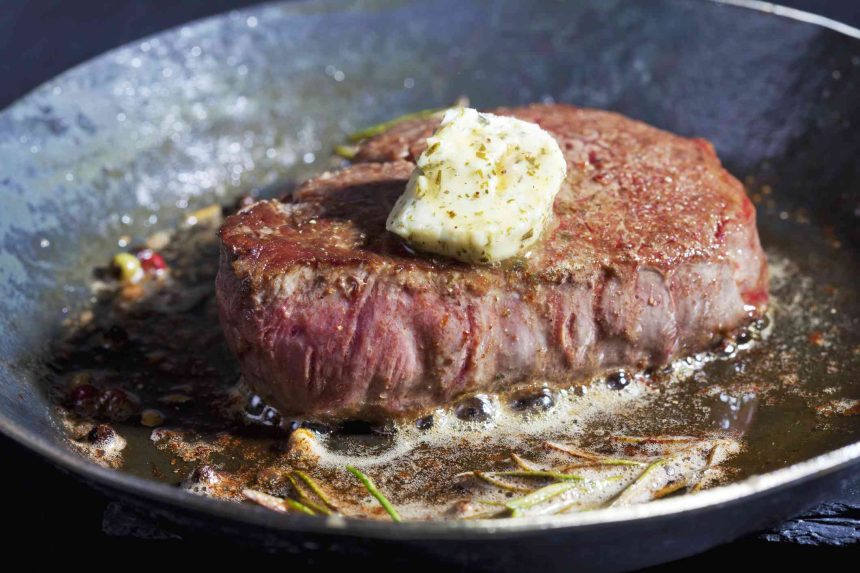| Beef tallow (1 tablespoon/12.8 grams) | Grass-fed butter (1 tablespoon/14 grams) | |
| Calories | 115 | 100 |
| Total fat | 12.8 grams (g) | 12 g |
| Saturated fats | 6.4 g | 8 g |
| Unsaturated fats | 5.9 g | 4 g |
| Cholesterol | 14 milligrams (mg) | 30 mg |
Beef tallow is animal fat mainly used for cooking. It’s made by separating meat from fat and purifying it.
It’s also grown in popularity as a skincare product. Several studies show that beef tallow can improve skin hydration. However, the results came from self-reported data, where people used beef tallow with other oils. More human studies are needed to confirm its skin benefits.
Beef tallow contains conjugated linoleic acid (CLA), a form of linoleic acid (a fatty acid). CLA is found in dairy, lamb, and beef and in small amounts in poultry, fish, and vegetable oils. Consuming CLA is linked to improved heart, immune, bone, and metabolic health. It may also help with weight management.
Most studies on CLA have examined supplements only. Research suggests that CLA supplements can help with weight loss and muscle building. However, supplementation can also cause side effects, such as insulin resistance. More studies are needed to confirm the benefits.
Grass-fed butter is generally made from the milk of cows fed with grass. Pasture feeding can influence the nutrient content of milk and butter. Butter is a major source of CLA, and grass-fed butter can have higher levels of CLA than regular butter.
Regular butter contains vitamin A and small amounts of vitamins E and K. Women need 700 micrograms of vitamin A daily, and men need 900 micrograms. One tablespoon of regular butter offers about 10% of the Daily Value (DV) of vitamin A for men and slightly more for women.
While regular butter is a good source of vitamin A, a study found that grass-fed butter has more vitamin A than butter from cows fed a grain-and-grass diet indoors.
Beef tallow and grass-fed butter have more than 50% of saturated fat. The American Heart Association (AHA) recommends choosing oils low in saturated fats and high in unsaturated fats.
Animal fats, such as butter, beef tallow, and lard, are high in saturated fats. Most vegetable oils, such as olive, canola, and sunflower oil, are high in unsaturated fats.
Saturated fats are found in many foods, including red meat, poultry, cheese, butter, baked goods, and ultra-processed foods. The AHA recommends limiting saturated fat consumption to 6% of daily calories. Reducing saturated fat can lower your risk of heart disease.
You probably shouldn’t consume grass-fed butter if you’re allergic to cow milk. On the other hand, most people with lactose sensitivity can tolerate butter since it contains considerably less lactose than other dairy products, like milk, yogurt, cottage cheese, and ice cream.
Here are some ways to use both grass-fed butter and beef tallow in your daily diet and cooking:
Beef Tallow
Beef tallow has a whitish color at room temperature and below. It has a neutral flavor with a slight beef taste.
Here are some tips for choosing, storing, and cooking with beef tallow:
- Beef tallow is not as good for baked goods as butter because it has a high melting point. The fat can solidify when the baked goods cool down, leading to an undesirable texture.
- Beef tallow has a smoke point of around 420 degrees Fahrenheit (216 degrees Celsius), making it a good fat for cooking at high temperatures, such as frying, sautéing, and pan-searing.
- It’s used in spicy dishes because its neutral taste helps balance the flavors of the spicy food.
- You can use it in spreads, condiments, and as a shortening.
Grass-Fed Butter
Grass-fed butter has a smooth texture and a yellow color. It has a rich, creamy, and slightly sweet taste.
Here are some tips for choosing, storing, and cooking with grass-fed butter:
- Check the butter package for the grade. AA is the highest quality, followed by A, B, and general.
- Use salted butter (it has less than 2% salt) for baking.
- Butter has a low smoke point of 302-347 degrees Fahrenheit (150-175 degrees Celsius), meaning it starts smoking at or above this temperature range. It’s best to use oils with a high smoke point when cooking at high temperatures to prevent harmful compounds like trans fats from forming.
- Check the “best if used by” or “use by” date for fresher butter.
- Store your butter in the fridge at 40 degrees Fahrenheit (4 degrees Celsius) or below, away from the door.
- If you won’t use leftover butter within a month, wrap it and freeze it for up to nine months.
Beef tallow and grass-fed butter are animal fats with a rich taste and various cooking applications. Although both are high in saturated fat and cholesterol, you can consume them in moderation.








